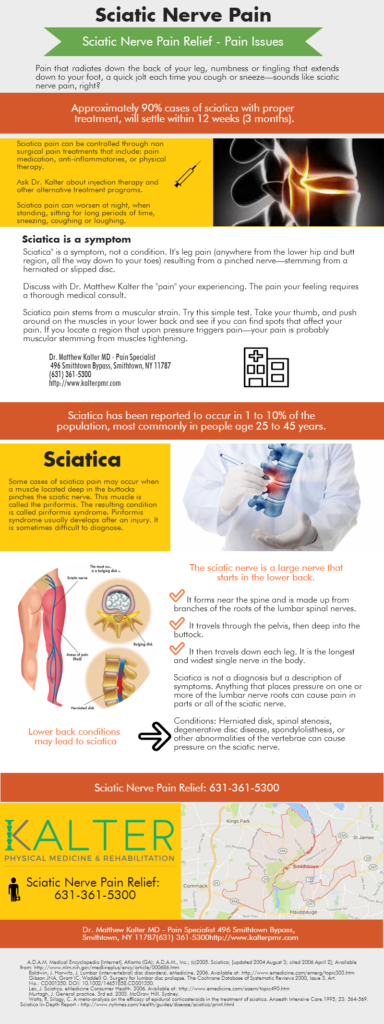The sciatic nerve is the largest and longest single nerve in the human body. The nerve originates in the lower spine as nerve roots exit the spinal cord (through gaps in the bones at the back of the spine), and extends all the way down the back of the leg to the toes.
The sciatic nerve may become irritated or compressed by conditions of the back, that include herniated discs, spinal stenosis, degenerative disc disease and spondylolisthesis.
Sciatic Nerve Anatomy: A Combination of Nerves
The sciatic nerve is comprised of five nerves. It is formed on the right and left hand side of the lower spine by the combination of the fourth and fifth lumbar nerves and the first three nerves in the sacral spine. Each nerve exits the spine between two vertebral segments and is named for the segment above it.
The nerve that exits between lumbar segment 4 and lumbar segment 5 (L4 and L5) is called the L4 nerve root, and the nerve that exits between the L5 and Sacral segment 1 is called the L5.
The nerves that emerge from the sacral foramen are called the S1, S2 and S3 nerves.
Sciatic Nerve Damage – Causes And Treatment:

Sciatica pain symptoms include weakness, numbness, or tingling in the leg. Sciatica nerve pain is caused by injury to or pressure on the sciatic nerve. Sciatica is a symptom of another medical condition.
Statistics:
- 4 out of 5 people suffer from Sciatica
- 80 to 90 % of people experience it during their lifetime
- More common in individuals between 30 and 50 years of age
- Sciatica most severe in women (Many women experience sciatica during pregnancy).
Causes:
- Herniated Disk – Bulging Or Ruptured Disc In The Spine
- Pressure On Nerve Roots
- Spinal Stenosis – Narrowing Of Spinal Canal
Bony outgrowths (spurs) along the joints
- Compressed or pinched nerve due to injury.
Symptoms:
- Radiating pain from lower back to hip to thigh to ankle or feet
- Sharp burning sensation
- Electric shock painful sensation.
- Tingling and numbness
Weakness of leg(s)
- Aggravated when sneezing, coughing or sitting for long periods of time.
- Worsening movements that extend spine – walking or lying down.
Diagnosing Sciatica:
- Diagnosed symptomatically
- Limited straight leg raise (SLR – Lasègue’s sign)
- X-ray
- MRI
Medications
- Painkillers – Acetaminophen (Generic Tylenol), or Naproxen (Generic Aleve), or any other NSAIDs
- Powerful muscle relaxants or narcotic painkillers
- Epidural steroid injections in the spine
Prevention
- Lower back exercise
- Appropriate posture during sitting and sleeping
- Avoid lifting heavy weights
Schedule an appointment : Sciatic Nerve Damage
Looking for a back in Smithtown, Long Island? Meet Dr. Matthew Kalter MD – Pain Specialist, Kalter Physical Medicine and Rehabilitation 496 Smithtown Bypass, Smithtown, NY 11787 (631) 257-1137 Our Twitter handle: @smithtownpainmd
Resources
- Sciatic Nerve – Anatomy Pictures and Information – InnerBody www.innerbody.com/image_nervov/nerv23-new.html
-
Sciatic Nerve Anatomy – http://mysciaticaexercises.com/sciatic-nerve-anatomy
- Sciatica pain relief – New York Spine Care Specialist, in Smithtown, NY. – www.painandinjury.com/sciatica.html
- 5 Ways To Tell If You Have Sciatica – http://www.prevention.com/health/sciatica-symptoms
